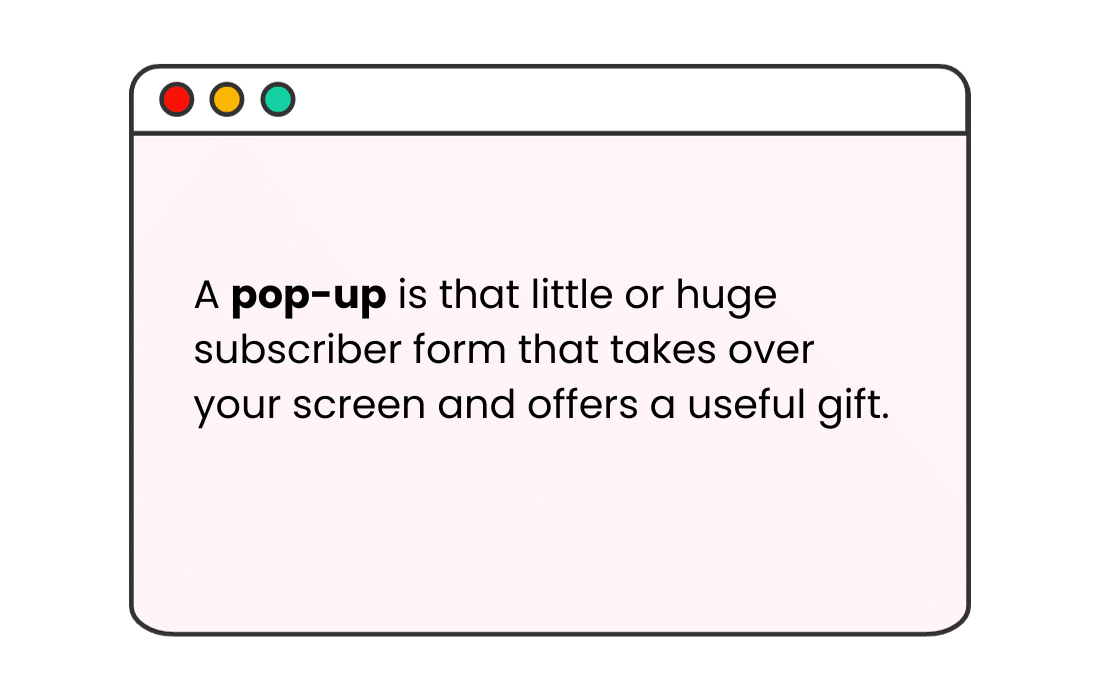Article by Colette Nichol, Solo Filmmaker and Story Strategist

It’s Easy for You to Say
I don’t consider myself an email list-growth expert.
But I am an expert at struggling with list growth and avoiding list growth like it’s my end-of-year taxes. Thankfully those are two issues that I’ve now overcome.
Where before, I wasn’t sure if I’d even be able to decode the key to driving traffic and bringing in new subscribers. I now have a system that helps me grow my email list by more than 200 subscribers each month. My goal is to continue improving that rate by adding one new strategy at a time and finessing it until it works well.
Table of Contents:
- Making list growth fast and easy.
- Website traffic 101.
- Starting with what’s worked in my biz for list growth
- List growth starter kit bonus.
- How to boost your conversions to build your email list even faster.
- Not making sales with your email list?
In addition to the list growth strategies I’ve used for my own business, I’ve helped my clients grow their lists.
One client went from a zero lead capture system and relied on just word of mouth to capturing and nurturing over 100 new leads per month. (For perspective, each lead had a value of over $1000.)
Another client doubled her online revenue using the list growth and email strategies I taught her.

What I’ve learned over the past few years is that list growth is possible for everyone.
Not just people who already have big lists. But the thing is: if you’re starting from scratch, then focusing on what a lot of online blogs and experts tell you to do isn’t going to get you anywhere.
Many list growth blog posts count on the fact that you already have a big website with a team of people working for you and a TON of organic traffic.
Let me guess…that’s not you?
These typical posts are written for corporate marketing wonks who just need to optimize their company’s website and get data they can report to the boss.
They aren’t written for the small bootstrapping business that needs to get results with a workforce of one.
One other thing: some of the techniques that worked well years ago aren’t so useful now. You may still hear people talking about certain tactics that have long since passed their expiration date.
Example: daily blogging with no SEO strategy in place. Prove me wrong, but in my opinion…ain’t gonna do anything for your business.
This post is so freaking long and comprehensive because there are tons of ways to grow your list.
But listen, you also need to know the basics that apply to everyone—immutable rules of list growth. So we’re covering everything you need to know here and now.
So buckle up my friend, ‘cause you’re in for an email-list-growth RIDE!

In this article, we’re going to cover these five things:
- The psychology of list growth
- How to grow your traffic
- How to increase conversions
- How to make sure you’re getting truly interested people, not tire kickers
- What to do if you’re not making any darn sales from your list growth activity
Making List Growth Fun and Easy
An essential key for a small business owner doing DIY marketing and list growth is picking a strategy that sounds fun.
But that’s not all! It’s got to fit with your motivational framework.
If you need to see instant results to stay motivated (whether those results are good or bad), then doing a strategy like Guest Posting isn’t going to work for you. It can take some time with zero results before you hit it big with a particular post.
If you get down in the dumps when you see “bad numbers,” then Facebook ads are going to be a nightmare.
That’s because most people have to go through a scary phase where everything is failing before you find a sweet spot.
There are motivational pros and cons for each list growth strategy. So before you pick a list growth strategy, please think about what your motivational requirements are.
What do you need to stay motivated?
Figure that out, then choose a strategy that’ll keep you motivated rather than make you feel down in the dumps as you wade through the initial lame-results phase.
If you’re still wondering why you should take my advice, it might help to tell you that I’m a HubSpot Champion User, and I’ve been in the online marketing space since 2015.
Hubspot is the world’s leading Inbound Marketing CRM and of the hundreds of thousands of HubSpot users, I was in the top 1000 last quarter. My HubSpot rep says this is a big deal, so I’m going to take her word for it.
My specialties are video marketing, list segmentation, and non-creepy sales-driving strategies.
Weird combo, I know—I’m the human equivalent of putting popcorn shrimp in a bowl with cornflakes and fudge sauce.

Enough about me, let’s talk about your list growth problem.
It’s All About Website Traffic
Beep beep!!!
Before we dive into this list-growth list (dare you to say that 10x), let’s make sure you’re clear about one thing: list growth is all about getting the right traffic.
Again for emphasis: list growth is all about getting the right traffic.
Whether you’re using a landing page or sending people directly to a blog post or another website page, you don’t get list growth if you don’t have traffic.
Last year I had the incredible luck of getting to steal 30 minutes of Laura Belgray’s time.
I got one-on-one coaching with Laura when I joined the Talking Shrimp B-School Group. It was only supposed to be a 20-minute session. But one of my superpowers is extending the length of any conversation by 30%. (FYI, I don’t do on purpose.)
If you’re new to the online space, you might not know that Laura Belgray is one of the best Copywriters on planet earth. Copywriters across the globe worship her for a good reason: she makes writing delicious high-converting copy look easy. Last year, she stopped doing one-on-one copywriting consults while also growing her revenue to over $1,000,000.
Laura’s big revolutionary tip in our conversation: focus on traffic, not conversions.
“Focus on traffic,” she said. And I listened.
When Laura Belgray says something, you should listen. This woman is a hype-free Midas.
Back to the big tip: focus on traffic.
It sounds simple, but it shifted the way I was thinking entirely. Before talking to Laura, I’d been so obsessed with increasing my conversion rates that I wouldn’t admit that I had a traffic problem.

Here’s the truth: I’d been avoiding what I knew was going to be a difficult task.
I honestly think I had a popularity block. You might have this mental block if you weren’t a popular kid in high school. You think, well, I never had a big group of friends, so why would I be able to grow a big and engaged audience?
Or, I don’t have genius people skills, so how am I going to attract tons of people to my website?
Maybe, I’ve just got one of those websites that can only ever get a certain amount of traffic.
You think that your success and website traffic has a glass ceiling.
Real talk—it doesn’t!
In almost any industry, there are websites getting tons of traffic and sites getting next to none. Getting traffic isn’t a magic act reserved for the bold and the beautiful. Nope.
Generating traffic is just a skill that you’ll gain when you give yourself some metrics and go after them with dogged obsession.

Yes, Conversions Do Matter, But Traffic Matters More
When we talk about conversions, we’re talking about what percentage of the people who see an opt-in form take action.
So someone sees your newsletter sign up, but do they do anything about it? The better your conversions, the higher the percentage number.
For landing pages*, marketers typically aim for a 20% conversion rate or better. For websites, getting even a 2% conversion is good.
But marketing all-stars are usually aiming for a 5-10% conversion rate on all website traffic.
So for every 100 people that come to their website, they want to capture 5-10 emails.
{*New to online marketing? A landing page is a website page with no navigation and no footer. Just one call-to-action, and that’s it.}
But, if you only have 100 people visiting your website each month, that’s still only 10 new people on your email list each month if you’re converting at 10%.
Mmmm, unless those are some super-dee-duper peeps who are ready to buy all the things right away, that’s not going to get you far.
The reality of list growth is that you have to bounce back and forth between focusing on traffic and conversions, which is probably why a lot of small businesses get stuck.
It’s not that uncommon for people to grow their lists like crazy and then run out of steam.
They just stop—no more list growth. I think that for some solopreneurs list-growth mental blocks are as real as money-blocks, which makes sense. The bigger and more engaged your list is, the more money you’ll make.
Well, as long as you’re selling stuff they want—they don’t just send you money in the mail ’cause they like you.

Quick review:
a) List growth is going to be one of the main parts of your work FOREVER.
b) List growth happens when you focus on getting great traffic (ideal clients!) to your website and giving them an offer they can’t refuse.
With that preamble out of the way, let’s look at some list growth techniques.
Starting with What’s Worked in My Biz for List Growth
If I were only to share the list of growth strategies I’ve used myself, this would be a shortlist.
And not a very useful one. Just because I’m doing it, doesn’t mean you’re going to want to do it. And just because I don’t bother with something doesn’t mean you shouldn’t.
No two businesses are the same.
So I refuse to be prescriptive. Instead here’s a ton of no-skin-in-the-game info for you to use when making a decision.
That said, let’s start with what I’m doing, and then move into what’s working for other businesses.

1. Combine a Quiz with Facebook Ads
From March 13th to May 13th of this year, I grew my list by over 500 people. I did this by myself. No team.
There’s one main reason for that. I created a quiz and promoted it with targeted Facebook ads. Right now, there are very few marketers creating quizzes for businesses. It’s still a novelty. And it feels fun.
So if your industry isn’t jam-packed with quizzes, this could work well for you.
There’s a lot of work on the front end, but very little on the back end. It probably took me about 30-50 hours to get my quiz and Facebook ads running so that my cost-per subscriber is low. But now, it’s a set-it-and-forget-it situation. I check in on the ads a couple of times a week.
Full disclosure: I’m building this list for a launch I’m doing in September, so for me paying to help the right people find me makes sense.
How can you make a quiz that doesn’t suck?
Take Chanti Zak’s five-day free email course on creating your first quiz. This course is honest to god the best free course I’ve ever taken.
No clue how to do Facebook ads?
Take one of Rick Mulready’s Facebook Ads courses. He’s an excellent teacher who breaks the whole process down clearly and simply. You cannot go wrong with his training.

2. Do SEO-Based Blogging
SEO-based blogging is a slow and steady method of getting traffic to your website.
The thing about this kind of traffic is that if you get your topics right, your visitors are primed to dive in. These are ideal people. They’re action takers. They were already online looking for someone to solve their problem. They want solutions, and they’re willing to go digital hunting.
As of 2020, no new online business should be without either SEO-based blogging or video creation strategy. I went without one for 5 years, and holy f**k do I regret it. I’m like a born-again SEO convert now.
Make sure you have an opt-in* that relates to the search traffic theme you’re going after.
{New to online marketing? And opt-in is a free gift that people get if they sign up for a form. I use ConvertKit. But you could use Squarespace built-in forms, MailChimp, MadMimi, etc.}
Some Examples of Lead Magnets
If you’re going after people interested in developing a growth mindset, you could have a 5-day email mini-course that helps someone develop a growth mindset in 5 days.
If you’re a Sound Bath practitioner, you could give people a free download and if you’re a Shamanic Practitioner, you could provide a guided meditation that takes someone into an inner world where they feel the beginnings of a transformation.
By blogging based on keywords with good search volume and low competition, you’re able to make friends with Google and attract online traffic to your website.
This is a long-term strategy. It’s also a forever strategy. The biggest names in the online education space do not stop their SEO strategy ever. Literally. Marie Forleo, who is one of the best marketers in the education space, is focusing on SEO in her business this year. (How do I know that? Well, I’ve seen her job postings.) If MF is doing something, you should take note.
How can you learn SEO?
You could do a ton of free reading and research, but I recommend taking a course. I am a Clapping Dog Media evangelist. I think everyone should take Meg’s courses. So, yeah, take one of Meg’s courses.
I also like Kerstin Martin’s basic SEO course and Rob Powell’s epic blogging for SEO course.
Finally, if you want to go free, you can’t go wrong with Neil Patel’s free training.
Starting from Scratch? List Growth Strategies That Work for Small Biz
3. Create Videos Based on SEO for YouTube
This is the same as SEO-based blogging, but you do it on YouTube using SEO tactics.
This works best if you’re in a low-competition industry where there aren’t a trillion videos already. If you’re in a high competition industry, you need to be religious about your video production. It needs to be every single week. Most people say you need 100 videos before you see significant channel growth. But what I’ve actually seen is that you need a few videos that get tons of traffic, and then you’ll see channel growth. The other key to channel growth is promoting the heck out of your videos.
This is something I can’t stand doing, so I suck at this tactic.
Then you’ve got to send your viewers from YouTube to your website or a landing page. Make sure you have an offer that relates to what your viewers most want to achieve or solve if you want this to work.
People who teach this: Sunny Lenarduzzi and James Wedmore
4. Be a Guest on Podcasts
Podcast listeners tend to be highly educated, earn a good income, invest in education, and are engaged listeners.
Podcasters who do interviews need a steady stream of guests on their podcast. Usually, that means 52 guests per year. Typically they’d have three months of guests planned in advance, so you’re not going to get a spot on someone’s podcast overnight.
This technique requires that you listen to a lot of podcasts from people in your space.
Then you need to pitch the ones where you think you could bring valuable insights to their listeners. You’ll want to have a free offer, i.e. an opt-in email gift that you can share with their audience at the end of the podcast. If there’s a perfect fit between your work and the audience, you could get hundreds of new subscribers from being a guest on a single podcast.
People who teach this: Selena Soo

5. Start Your Own Podcast
Well, that’s a hell of a lot more work, isn’t it?
It depends. If you’re not one for outreach and research, then just creating your own thing might feel easier than being a guest. The podcast space is not jam-packed with content, so it’s still somewhere you could get your foot in the door.
And more importantly, audio creates a higher level of trust and intimacy with your audience than just the written word.
There’s no way I’d have flown to Texas to take Sean D’Souza’s live sales page workshop if I hadn’t been listening to his podcast.
{Takeaway: Consider getting into the audio game even if you don’t want to do a full-on podcast.}
If you do a podcast, make sure you’re sending people to your email opt-in at the end of every podcast.

6. Do Guest Blogging
There are thousands of huge blogs that need 20+ articles per day to survive.
They have built-in audiences, huge email lists, and gigantic social media followings. If you write for one of these blogs and get featured on their email list or on social media, it could mean a lot of traffic to your website. But….not always.
There are a few keys to guest blogging.
Your author bio needs to be right below the guest post. If a site doesn’t put an author bio right below the article, you’re not going to get website traffic. Do your research. Find blogs that have audience alignment, and only pitch or write for the ones that offer a prominent author bio where you can include your free gift opt-in link.
One of the other benefits of guest blogging is that you can build backlinks to your website, which is beneficial to your website’s SEO juice. If you have enough websites linking back to your site, then Google thinks you’re more legit and will rank your website higher in search results.
People who teach this: Suzzie Moore teaches it in her course Five Minutes to Famous
7. Promote Your Content to an Underserved Niche Audiences
I accidentally became in demand as a video creator for financial advisors.
After making one video for a financial advisor, suddenly, more advisors wanted videos made as well.
That’s quite a specific niche. But knowing that niche exists, I could market directly to financial advisors and have much greater success than if I were to just be generic about my marketing.
People want to feel seen, heard, and understood.
So the more specific your marketing is, the better your conversions will be. About your content, this means you could create a blog post or video that has examples related to a specific niche. Then you could promote that content to the forums, associations, Facebook groups, and influencers in that space as a helpful free resource.
This tactic is something that Derek Halpern of Social Triggers says he’s used to growing his business off around 10 pieces of content (if I recall correctly). His method: spend 20% of your time making content and 80% of your time promoting it.
Not a path that everyone’s going to enjoy. Still, you can see its merits, especially if you work with a VA to create a list of contacts to promote your work to and your niche is in your ideal client zone.

8. Become a Social Media Maven
Yeah, you know, totally casually blast your way onto the social media scene…she says sarcastically.
I have to include this because it’s something everyone thinks they’re going to magically do. And it’s not like it’s impossible. People still do it. You can build an audience on social media, even if you’re starting from scratch. But you have to be a genius (i.e. totally on target) with your content creation, or you have to use paid advertising. Or you have to have the patience to experiment until you hit a home run.
If you LOVE social media and this is the route you want to go, it’s a good idea to take a course on this.
It’ll save you a lot of time. Keep in mind that the point of your social activity is to build your email list. It’s enough to just build a social following.
The goal is to build trust and rapport and bring your new friends over to your website, where they become email subscribers.
You’ll also want to use a social media scheduler such as MeetEdgar, Keep, or Hootsuite to schedule your posts.
People who teach this: Jenna Kutcher, Jasmine Star, Laura Roeder of Meet Edgar
9. Do Free Guest Lectures (and then paid guest lectures)
Since we’re currently in the middle of a lot of lockdown situations, people might not be able to race off and do a guest lecture.
But once the doors are open to public gatherings again, this is an idea worth considering if you happen to enjoy public speaking. The most important thing here is to choose your audience wisely. Only do gigs where there’s alignment between the audience and your business. And of course, make sure you have a useful tool that you can refer them to on your website.

10. Leave Testimonials for Programs that You’ve Enjoyed
If you’ve taken a course that you love, well, leave a darn testimonial!
You’re not going to grow your list by the thousands doing this. (Well, I doubt you will.) But it’s good karma. Hey, you’re going to want testimonials in the future. And people will come over from another person’s sales page to see what you’re up to if they find your success story interesting. As long as you genuinely LOVE a program or course and your testimonial is genuine, you should always do this. Be generous with your love, and it’ll come back to you.
11. Try using “Help A Reporter”
This is best if you want to also build backlinks that’ll help your domain authority.
(Meaning: links from other websites to yours, which makes Google think your website is more legit.)
It’s also useful if you’re looking to have more social proof media logos for your site without writing full articles. If your words are featured in an article, you can use that logo under a “Featured In” headline. I know a few people who have used this technique with success, and it’s on my to-do list. You know…that list that goes on forever.
12. Go all-in on PR and Focus on Getting into Media Outlets
Some people think that to get PR, you have to have the world’s most magnificent website and totally full client roster.
Well, that’s not the case. I’ve seen a lot of poorly crafted success and business coach websites recently. So how are these folks making any money if their website sucks? Because they’re focusing on PR, speaking gigs, and guest blogging in high-profile places. (Or maybe they have some under-the-table gig…but I’m betting their magic bullet is PR.)
As long as you have a story angle and something valuable and timely to share with a media outlet’s audience, you can get free publicity.
I’m not saying you should try and get on the Today Show tomorrow. But if you read a couple of books about PR and getting media attention, you’ll be able to figure out what your angle is.
You could also take the self-study version of Selena Soo’s course Impacting Millions. Getting free publicity will drive traffic to your website. If it’s the right media outlet, many of those people will subscribe. Side note: this tactic is so not my cup of tea. But if this idea excites you, it might be your thing. Just know that not all PR agencies were created equal, so if you are looking to hire an expert, do your research.

13. Self-publish a Book about a Highly Searched Topic
And make sure your title contains keywords that people will search for on Amazon.
Um, yes, I know this isn’t a small undertaking. So I’m not suggesting this is your overnight answer. But if you’re already planning on self-publishing a book, do it strategically. Make sure that your title has been run through the SEO gauntlet.
Make sure your title contains keywords that people actually search for.
People use Amazon as a search engine. Smart people are especially prone to this. You have a problem, and you want to read a book on the topic. How many times have you gone to Amazon and just typed in a topic you want to learn about? Well, your audience does the same thing.

14. Ask for Referrals from your Email List
Once in a while, ask your email list to forward an email to someone they think might enjoy it.
I wouldn’t necessarily do this every time as it’ll become white noise. But you can make an obvious ask about once per month, and nobody’s going to get upset with you. If that makes you uncomfortable, you can keep the ask permanently at the bottom of the email. Then add a button where new people can click the email and opt-in.
15. Create an Opt-In that’s Highly Shareable and Desirable
Free gift, opt-in, lead magnet, freebie, giveaway…it’s all the same thing.
In online retail, the most common opt-in is a discount code. And frankly, that works exceptionally well. I’m on the email list of hammock companies because I want the 10% off when I buy a hammock. I haven’t bought it yet, but I definitely will. And when I do, it’ll be from the hammock people who are in my inbox.
BUT, if you’re not in online retail, then you need a free gift that is desirable and shareable.
Think about your ideal client’s biggest problems and how you can create a solution or transformation for them that fits with a topic you’re passionate about. Then go to it!
Chanti Zak’s online 5-day quiz creation mini-course (one of her opt-ins) is so good you’ll want to send her money in the mail. I’ve told multiple people about it and will continue to do so until the end of time. A friend of mine told me about Wim Hoff’s mini-course. I ended up taking it, and I’m on his email list now. Of course, Wim Hoff is now a legend, so he doesn’t even bother emailing his list. But anyway…we’re not all the IceMan.
16. Collaborate with Other Business Owners
If you know other business owners in complementary industries, you could provide their email list with something valuable.
Reach out to people you know, or people who are on the same business rung as you and co-promote each other or do a collaboration.

17. For Product-based Businesses, Do Fairs or Trade Show and Run a Contest or Draw
If you have a product-based business, your number one goal in doing Fairs or Trade Shows should be getting your ideal people’s email addresses.
And, of course, making an emotional connection with them. If you don’t have a wonderful email sign-up incentive, you’re throwing away your precious time at a fair.
Now, if you don’t love being vocal about your newsletter, you can do an epic product giveaway each month.
Make a display that shows the products you’ll be giving away to one winner each month. All they have to do to enter the draw is to join your email list. People will join. You won’t even have to say anything.
How do I know? I’ve done it. But don’t be a wilting daisy about it. Make the display as big and bold as you can while still being within your style. Also, make sure you don’t call it your email list. Call it something fun.

18. For Live-Event Businesses, Do a Giveaway As Well
Do the exact same thing as product-based businesses, but do it for your events.
Let’s say you do meditation classes. All you have to do is buy a beautiful and eye-catching basket (or another receptacle) to stick next to your payment zone.
Put a big gaudy note on the basket handle that says:
“Get weekly emails with meditation and wellness tips + enter to win one month of free meditation classes.”
You can also add that you’re giving away a month of free meditation classes to one person on your email list every month. Wow! That’s a fantastic incentive.
If you leave a stack of mini forms for your clients to put their name and email address, they’ll take action.
They’ll write down their name, and they’ll put it in the basket. The end. All you’ve got to do is go home and put all their emails into your list manually. Hint: don’t be subtle about this.
People don’t even read the signs on doors telling them if it’s PUSH or PULL.
So if you think being subtle is going to work, think again. Be about 50% bolder than you think is reasonable, and you’re probably in the right ballpark.
Listen, if you’re not great at marketing and promoting yourself and your business and your list, then you need to do things where people already “get it.” People understand the concept of a free giveaway. If they like your service, they’ll want in. And they’ll be happy to get your emails as well. If you’re in a country with strict marketing regulations (GDPR) then you’ll need to add a checkbox for that on your mini form.

19. Offer a Free Online Workshop to a Niche Audience and Promote It to their Association(s) and Groups
People love freebies that are specific to their needs.
If you know that you want to work with a specific group of people, and you know their needs, you can create a 1-2 hour free workshop about a topic that is deeply important to them.
If you reach out to most associations’ Communications Director or HR Manager with a valuable no-strings-attached offer, they will share it.
They might even share it on social media. People want to share useful offerings with their people. Also, pretty much every association has a newsletter, and they all enjoy sharing valuable links in their newsletters. It makes ’em look good!
Do this well in advance. It won’t work if it’s last minute.
20. Teach a Course at a Local College
This probably only makes sense if you’re in the education space.
But if you are, this is a great way not only to become a better teacher on your topic but also to build word of mouth about your services and your email list. Obviously, the list-building would be secondary to what you gain personally and professionally as a teacher.
But you will, over time, also grow a client base from teaching.
When I taught ESL at the Fulbright Institute in Ecuador, I ended with an accidental side hustle that paid quite well. I kept getting referrals and requests for private one-on-one instruction. When I’d been doing corporate language training, I hadn’t received many referrals because I only saw a few people per week. But as soon as I was teaching 30+ students every ten weeks, the referrals skyrocketed. It’s just a numbers game. Also, people who take live group classes are usually message-spreaders.

21. Become a Guest Teacher on Someone Else’s Program, Workshop, or Course
Help someone help their people.
If you’ve been following someone’s work for a while and on a similar level professionally, you might consider offering to teach their audience something in their next program. Maybe you teach storytelling, and another person teaches video production. Those two areas have a crossover. Or perhaps you’re a color expert, and a colleague teaches interior design.
You could teach an entire segment in one of their courses.
If they have a good-sized audience, then doing this for free is of benefit to you. It’s also great for them as it makes their course more robust and useful. Win, win!
22. Approach Education-Based Businesses to Create a Bonus for Their Course
People love bonuses.
And creators love giving their audience bonuses. You’ll probably face some rejection with this method unless you think about it in a highly strategic manner. The idea is to provide a bonus that another person’s audience would absolutely LOVE to have.
Write the creator and let them know that you’d be happy to do this if they’re interested.
Obviously, if someone asks you to do this, say yes! List growth will become easier if other people’s audience jumps on your bandwagon.
23. Send a Freebie Invite to Anyone You Meet Who Would Benefit From It
This doesn’t have to be an aggressive sales pitch of any kind.
It’s as simple as sending out an email saying,
“Hey, I created this thing. You might really like it. I also send out newsletters about {awesome thing}, which you might enjoy. Here’s the link. Check it out!

24. Post Thoughtful Comments on Other People’s Blogs
Posting real (not spammy) comments on other people’s blogs and on forums was a mainstay of how people built their audience before social media.
It was how bloggers got to know each other. Now I doubt that doing a ton of posting in forums would still work for audience building today, but a consistent commenting strategy could work.
This strategy is something that Susannah Conway recommends in her lovely heart-centered business course. Will it definitely work for audience building? I’m not sure. But if done consistently and with love, it will definitely help you make some business friends with whom you might try the next strategy.

25. Share your audience with another Blogger/Business & Vice Versa
Have you ever noticed that the big names in online business and marketing all seem to know each other?
They’ll pop up on each other’s blogs, podcasts, videos, conferences, programs, etcetera. They’re audience sharing. There’s a lot of cross-over between one biz expert and another. If your work is in the world of wellness, you can audience-share with another person whose work is in that world.
Heck, you could even share your audience with someone in the exact same industry as you but who sells a different product or a complimentary product. It’s also okay to audience-share with people who sell the exact same thing as you.
Have you noticed how musicians are always doing collabs?
Bruno Mars and Cardi B…what’s that all about? They’re elevating each other’s brand and audience sharing. If it’s good enough for Cardi and Bruno, it’s good enough for you.
And yeah, this is my blog, so I’m sticking a not-office-appropriate music video in the middle of it ‘cause I can. 😉 What’s the point of being self-employed if you can’t play videos in the middle of your workday?
Collab to Build Your Audience
Example Video
26. Write “Best Of” Posts
I’ve received this tip from a few successful bloggers.
And Rob Powell has even made an entire mini-course on this topic. Here’s the idea: write a list post about the best people or businesses in an area related to your industry. Then reach out and share the list with the people you’ve featured. They may or may not share it. If they do, that’s a lot more people coming to your website.
Another version of this idea is to take a topic and reach out to some experts in your industry and ask them a single question.
Create a list post based on these experts’ answers to that question. Again, they’ll probably share it. Obviously, make the subject interesting and useful to both them and your audience. This is a fun idea as it also helps you build goodwill and community with other people in your industry.
One big tip here is to not reach out to people who have stratospheric levels of success.
They will most likely not have time to participate. Reach out to people who are a little bit ahead of you or who have a similar audience size. They will appreciate the exchange of exposure.
List Growth Starter Kit Bonus
EMAIL LIST BUILDING TIPS FOR NEWBIES
Just starting out?
Reach out personally to everyone you know who would be a good fit for your newsletter. Do this via email, DM, LinkedIn, etc., and let them know about your newsletter and the free gift. Invite them to join you.
This includes past clients, current clients, colleagues, friends, family, acquaintances…anybody who would ALIGN with what you’re creating.
This alone can help you generate your first 100 subscribers!
Which feels pretty good.
How To Boost Your Conversions to Build Your List EVEN Faster

Now that we’ve talked about the basic list-building tactics in terms of traffic let’s dig into conversions for a hot minute.
Do all or some of these things:
27. Put your opt-in on your email signature for your business and personal email address.
Make sure you have a snazzy one-liner that builds curiosity about the lead magnet.
If you’re getting stuck, just do the lazy-girl’s version and put something like this: Are you reading the Story Envelope Blog?
28. Put your lead magnet link on all your social media profiles.
Your personal Facebook page has a spot for a URL.
Make it the link to your freebie. Do the same on Instagram.
29. Optimize your lead magnet. i.e. make sure it’s something that your ideal client wants A LOT.
This might mean tweaking the headline using the Co-Schedule Headline Analyzer tool.
Or it might mean re-thinking your lead magnet completely. Sometimes your first free gift is a wash. It doesn’t work. Nobody wants it. You won’t know if that’s the case until you have decent traffic. So first get some traffic, then optimize the headline and description. Then think about a new opt-in that’s deals with a bigger pain point if you’re not getting results.
30. Add a pop-up to your website with your lead magnet.
(A pop-up is that little or huge subscriber form that takes over your screen and offers a useful gift.)
Some people hate pop-ups. It doesn’t matter.
Almost everyone uses them for good reason. They work. And nobody will stop working with you because you happen to have one. Some people have been in business for a long time who don’t need a pop-up. That’s fine. But their advice about not using one is perhaps not to be heeded.
If you’re new to audience building and have a fan-freaking-tastic free gift, try out a pop-up.
Make sure the timing isn’t annoying. And make sure it’s easy to click away. Side note: it’s exciting to see that Squarespace 7.1 now has some fantastic pop-up options. Go team Squarespace!

31. Use an Opt-in Landing page, Not Just a Form.
This can be a huge conversion generator.
I’ve used this myself in a few different settings, and I promise you that it makes a difference. Instead of just having a form, you can write a sizzling headline about your free gift and have a button that your visitor will click.
They are then taken to a landing page with a beautiful design and a clear offer about what they’re going to get. If you’re new to the online space, here’s some info about landing pages. A landing page has no navigation bar and no footer. You arrive there, and you get ONE thing.
I’ve created beautiful landing pages with both ConvertKit and Squarespace.
Landing Pages convert higher than forms. But, that’s also because the audience has been pre-qualified. Nobody clicks to go over to a landing page if they aren’t interested.
Once pre-qualified people arrive at a landing page, they can consider the offer more easily because they aren’t distracted.
32. Put Your Freebie Sign-Up Form in Your Website Footer
This can provide you with incredible results.
In one company I worked with, most of our results came from the opt-in form in the footer.
Now, I’m not saying you should just have some tiny sad form that says: Sign up for my newsletter…the end.
That’s not going to do much. But have a proper block form with a headline and some benefit-driven copy. Make it short and desirable.
Make it bold!
Another way to try this technique is to link your landing page in the footer rather than direct signup, i.e. combine #4 with #5.
33. Put an Opt-in Link on Your Email Newsletters
People sometimes forward your emails to friends and colleagues.
Make it easy to opt-in to your newsletters straight from someone’s inbox.
34. Ask your Audience to Forward your Newsletter to a Friend
Just ask nicely at the end of an email once in a while.
Referrals can be a great way to grow a quality list.

35. Solve a Problem with Your Freebie
Make sure your lead magnet solves a problem that your ideal client struggles with.
Also, provide them with a TRANSFORMATION. If you’re ready to create a new free gift, consider how you can change your ideal client’s life in some small way. Create something in-depth like a 5-day mini-course or a video series or even an audio series. Focus on your ideal client’s pain points and how you can create a simple solution for them.
36. Make People Feel Good!
Have you heard that saying that people won’t remember what you do, but they will remember how you made them feel?
It’s so true.
So do everything in your power to make your new online audience FEEL GOOD. Respond to comments on your blog. Write back to people who send you emails. Be encouraging in the work that you produce. You’re building a platform. Make sure what you’re building gives people positive feelings.

37. Create Blog-post-specific Freebies, Also Known as “Content Upgrades.”
So you’ve got some traffic coming to your website.
You also have some highly popular posts. Great! Now you can be extra tactical and create an ultra-specific freebie that relates to each popular post. Start with the popular posts that feel like they would be read by people who are further down the path of their buyer journey.
If you have a post about learning something and a post that’s just story-based, choose to make a freebie for the one that’s about learning.
Why? Because those readers are further on their buyer journey.
Okay, then what?
Make one piece of highly useful content for that post that your reader will be able to access if they are opt-in.
It could be a tactical download, a workbook, audio, a two-part video series, a 3-day email course. Whatever it is, make sure it’s useful and desirable.
>> Don’t bother doing this until you have enough traffic to have popular posts.
Almost the End!
Phew! We’re almost there.
Before you click away and start pondering your business, read through the list of potential sales mistakes below.
Not making sales with your email list?

What happens if you grow your email list, but none of your new audience members want to make a purchase?
Uh oh! Two thumbs down. Let’s discuss.
This could be happening for a few reasons.
Here’s a list of potential reasons your email list might not be taking action and becoming clients:
1. Your free gift isn’t designed for action takers and is low commitment.
These people might not be ready to commit. So you could see a lot of people become clients a few years from now, but not right now. A checklist could convert well but might result in a lot of audience members who are not ready to take big action.
2. Your blogging hasn’t been designed with people who are ready-to-buy in mind.
If you’re writing randomly about your topic with no consideration for the TYPE of people you’re attracting, you may have a list that isn’t ready to take action. Go to Neil Patel’s SEO training page and find the pdf with 220 Profitable Buyer Keywords.
3. You might not be selling or pre-selling enough.
If you write beautiful emails but never mention your products or what you sell, it’ll come as a shock when you suddenly try to sell something. Mention your products and services frequently. Talk about what you’re creating. Talk about behind-the-scenes stuff. Tell stories related to your products and services. This is called a pre-sell. And it’s a gentle and friendly way to generate interest without shoving something down people’s throat.
4. If you try to do a launch and only send out three emails, you’re probably not going to get too far.
Unless you have a hyper-engaged audience of people who are ready to buy, and your products have a low cost and high desire factor.
5. You’re not communicating with your audience consistently enough.
If you email once in a while, then don’t expect to make sales. You have to earn your audience’s trust and love. You have to SHOW UP over and over before people will be willing to work with you. First, you build a relationship, and then your people will be happy and excited to buy. Do not expect to build a flourishing business if you constantly ghost your list. That’s like expecting to have an incredible romantic relationship with someone you talk to once per month. Ain’t gonna happen. Your partner needs to wined and dined, and so do your future clients and customers. With online marketing, delicious emails are the equivalent of giving a no-strings-attached massage.
6. You’re doing everything right, but you’re still not selling your course or membership or coaching. You probably have a sales page and launch problem. Your sales page probably doesn’t communicate your value well. It might have a weak headline or confusing copy. Maybe your pricing is complicated and confusing. What about the design? Is it gorgeous or wacky? Or your launch sequence might not help people understand what they’re going to get and how it’s going to help them. It might be as simple as lacking the right guarantee or refund policy.
Want some help with all of this?
If you’d like some tactical and strategic help figuring out what you’re doing wrong or how you can get it right, click the link below.
I’ll be opening up a few strategic coaching spaces every couple of months. Get on my email list, and you’ll be the first to find out when they become available.
If you’re in the middle of a list-growth or sales emergency, click here to send me an email.
Also, if you just want to get entertaining emails with useful and simple marketing tips for creative small businesses, sign up!
You’ll also get some free gifts…obviously.
If you have more awesome list-building techniques that apply to small business owners running, put them in the comments below.
Share your know-how so we can all get smarter together! 🙂
Learn Filmmaking and Get the Gear Guide
If you’re interested in learning filmmaking, check out the Solo Filmmaking Mentorship Program I created for aspiring filmmakers and video creators. It usually goes live once per year. So I recommend getting the Story Envelope Filmmaking letter which comes out a couple of times per month. That way, you can get filmmaking tips for free and find out when the filmmaking course is going live again.
Also, before you go, grab the Solo Filmmaking Gear Guide and Checklist for Beginners.

About the Author
Hi! I’m Colette Nichol. I’m a solo filmmaker and story strategist based out of rainy Vancouver, Canada. I’ve been making videos and micro films for small businesses and global brands since 2014.
Plus, I LOVE to help aspiring filmmakers pursue their dreams and start making films. This blog is designed to help you gain the knowledge you need to become a filmmaker.
If you want more, get on the waitlist for the Story Envelope Academy Solo Filmmaking Mentorship Program. It opens up one time per year and is the best way to become a filmmaking or video pro fast!
CLICK HERE to get on the solo filmmaking mentorship waitlist.